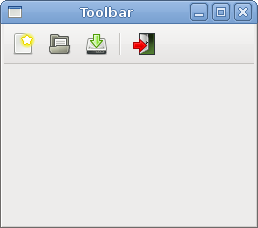
- Javafx buttonbar vs toolbar how to#
- Javafx buttonbar vs toolbar mac#
- Javafx buttonbar vs toolbar windows#
In fact, you can insert any JavaFX control into a ToolBar.Ī ToolBar is a control which displays items horizontally or vertically. Actually, a JavaFX ToolBar can contain other JavaFX controls than just buttons and icons. The JavaFX ToolBar class () is a horizontal or vertical bar containing buttons or icons that are typically used to select different tools of a JavaFX application. To add an image to a button − Create an Image object bypassing the path for the required graphic. This method accepts an object of the Node class representing a graphic (icon). You can add a graphic object (node) to a button using the setGraphic () method of the Button class (inherited from class). The tutorial describes relevant APIs and provides working examples that you can compile and run.
Javafx buttonbar vs toolbar how to#
In this tutorial you learn how to use properties and binding in JavaFX 2 applications. This is shown at the following link: JavaFX Text Field.

Therefore, if a user enters in the name David, the statement, "The name you entered is David". When a user clicks on the button, the label named labelresponse is set to "The name you entered is " followed by the name entered thorugh the setText () function. A JavaFX Button can have a text and an icon on it which indicate to the user what clicking the button will do. Cancel: A Cancel Button is the button that receives a keyboard VK_ESC press, if no other node in the scene consumes it.Ī JavaFX Button control enables a JavaFX application to have some action executed when the application user The JavaFX Button control is represented by the class. Default: A default Button is the button that receives a keyboard VK_ENTER press, if no other node in the scene consumes it. A button control has three different modes. The button control can contain text and/or a graphic. Use the following line to create button object. How to create a Button? Button can be created by instantiating Button class. An event is generated whenever the button gets clicked. A button is a component that can control the behaviour of the Application. JavaFX button control is represented by class. The function setTitle () is used to provide title to the stage. The button will be created inside a scene, which in turn will be hosted inside a stage. Program to create a button and add it to the stage: This program creates a Button indicated by the name b. Other programs may only show the menu when the mouse pointer is moved to the top of the screen or when scrolling up.Below programs illustrate the use of Button in JavaFX. With these programs, press the Alt or F10 any time you want to open the file menu. Some programs may also hide the file menu to keep the interface clean. For these programs, you'll need to use the alternative menu system. Other programs may use a hamburger menu, kebab menu (e.g., Chrome), or meatballs menu (e.g., Edge) to access the programs features. For example, in new Office programs instead of a file menu it uses the Ribbon. Finally, use Spotlight to find any files on your computer.Next, the status menus display quick information about things like the sound, Wi-Fi, battery, time, etc.The middle File, Edit, View, Go, Window, Help all interact with the Apple OS or program you're currently running if one is open.

To open Finder, click the Finder icon on the dock. By clicking the Apple logo in the left corner of the menu bar, you'll gain access to the Apple menu.
Javafx buttonbar vs toolbar mac#
The following is a diagram of a simple Mac menu bar and the functions of each menu item: When you switch to another application, the menu bar changes accordingly.
Javafx buttonbar vs toolbar windows#
Unlike Microsoft Windows menu bars, which appear in each window, menu bars in OS X always appear at the top of the screen. The menu bar on a Mac is a thin bar found anchored to the top of the screen.

To show the menu bar move your mouse or finger to the top of the screen. With Windows 8, Windows 10, and full-screen programs, the menu bar may be hidden to improve the appearance of the program.


 0 kommentar(er)
0 kommentar(er)
